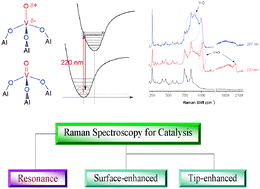Resonance Raman (RR) spectroscopy has several advantages over the normal Raman spectroscopy (RS) widely used for in situ characterization of solid catalysts and catalytic reactions. Compared with RS, RR can provide much higher sensitivity and selectivity in detecting catalytically-significant surface metal oxides. RR can potentially give useful information on the nature of excited states relevant to photocatalysis and on the anharmonic potential of the ground state. In this critical review a detailed discussion is presented on several types of RR experimental systems, three distinct sources of so-called Raman (fluorescence) background, detection limits for RR compared to other techniques (EXAFS, PM-IRAS, SFG), and three well-known methods to assign UV-vis absorption bands and a band-specific unified method that is derived mainly from RR results. In addition, the virtues and challenges of surface-enhanced Raman spectroscopy (SERS) are discussed for detecting molecular adsorbates at catalytically relevant interfaces. Tip-enhanced Raman spectroscopy (TERS), which is a combination of SERS and near-field scanning probe microscopy and has the capability of probing molecular adsorbates at specific catalytic sites with an enormous surface sensitivity and nanometre spatial resolution, is also reviewed (300 references).

You have access to this article
 Please wait while we load your content...
Something went wrong. Try again?
Please wait while we load your content...
Something went wrong. Try again?


 Please wait while we load your content...
Please wait while we load your content...